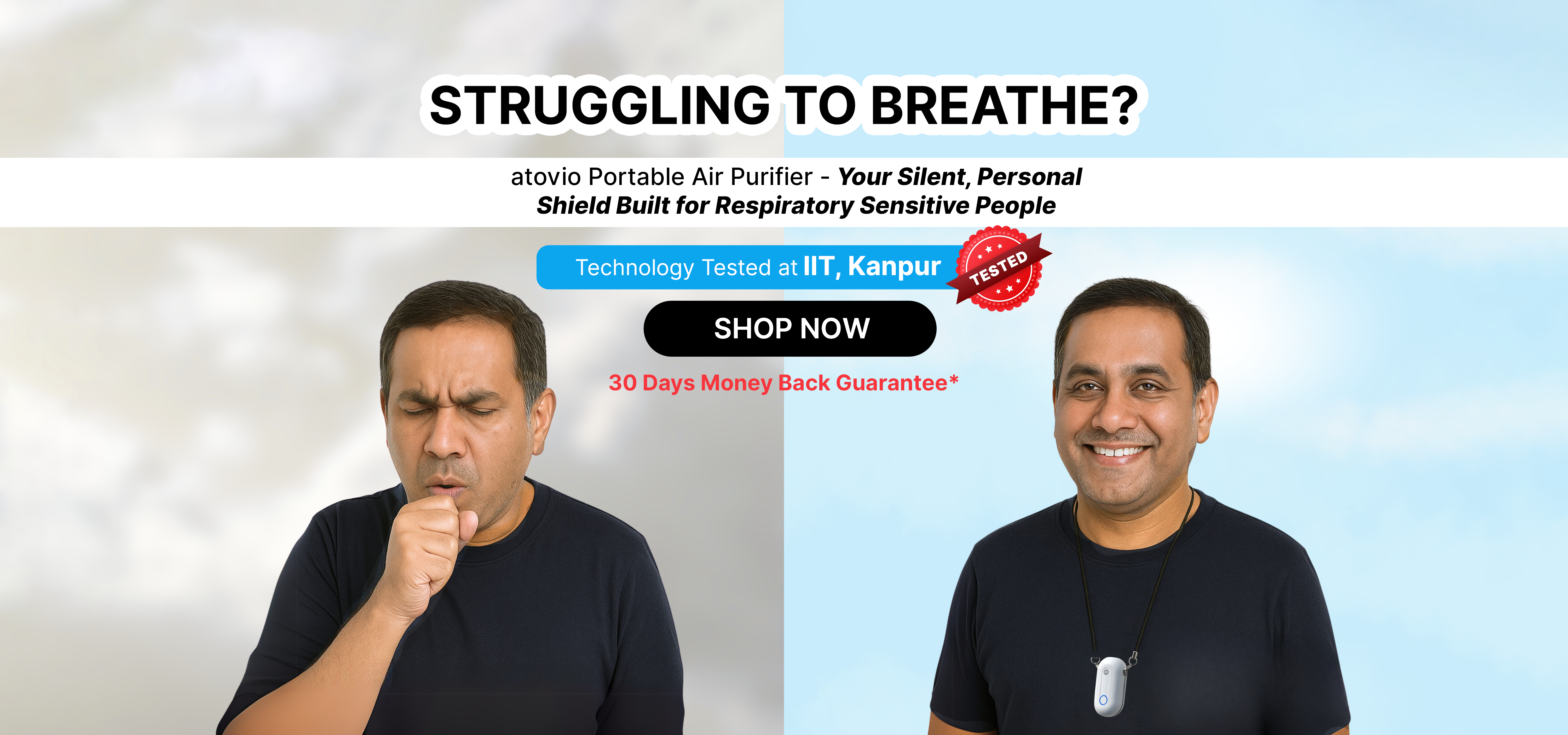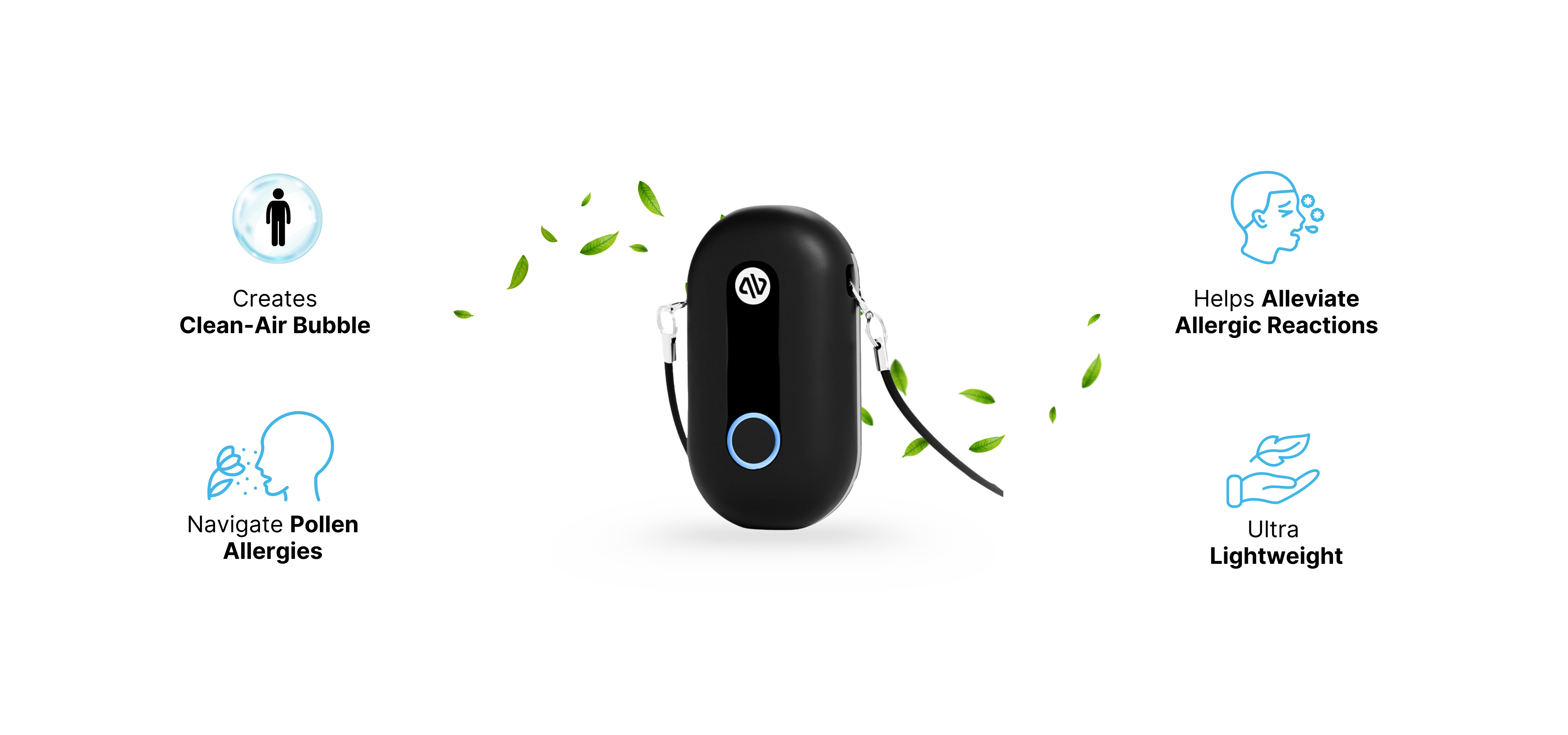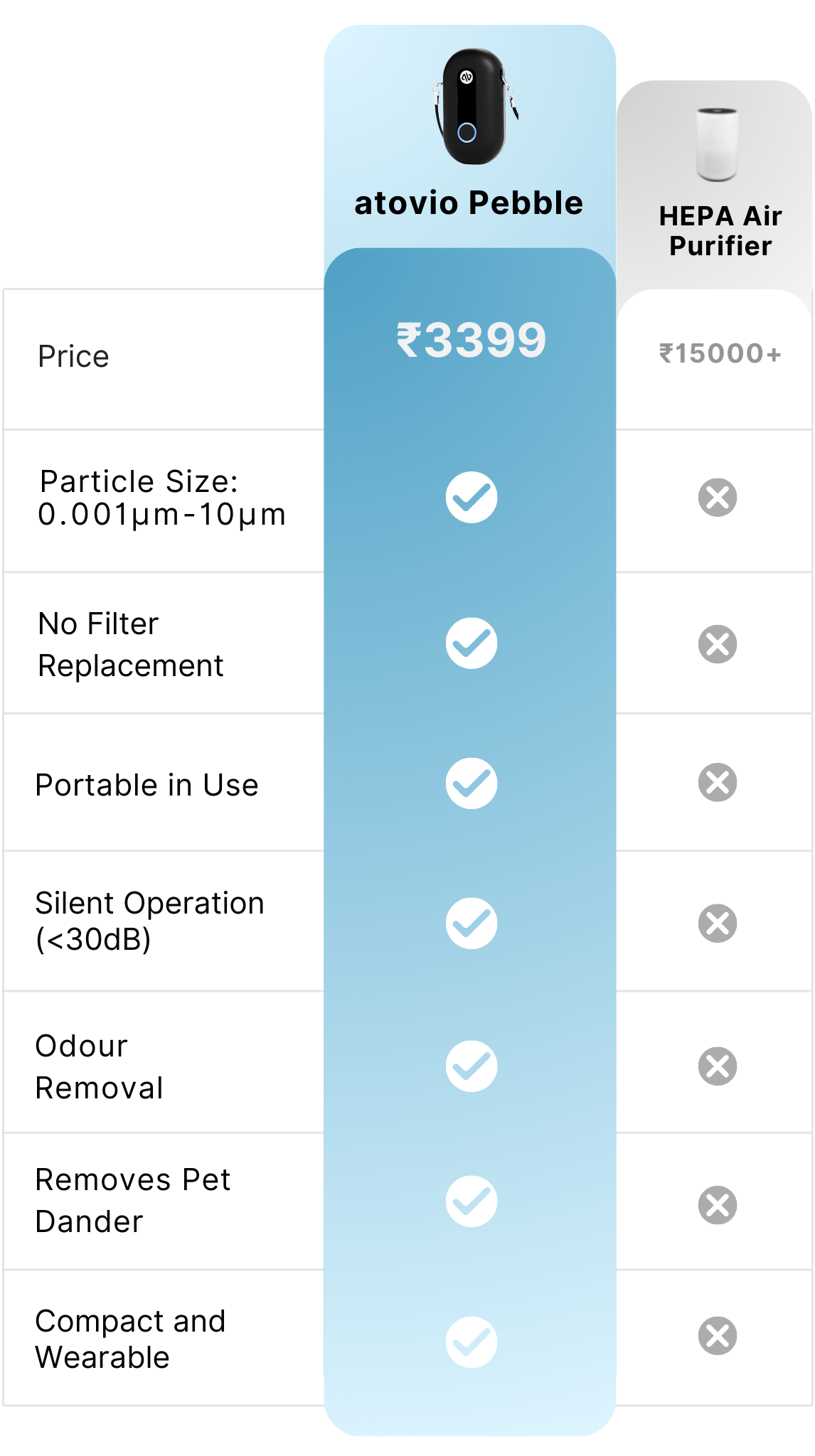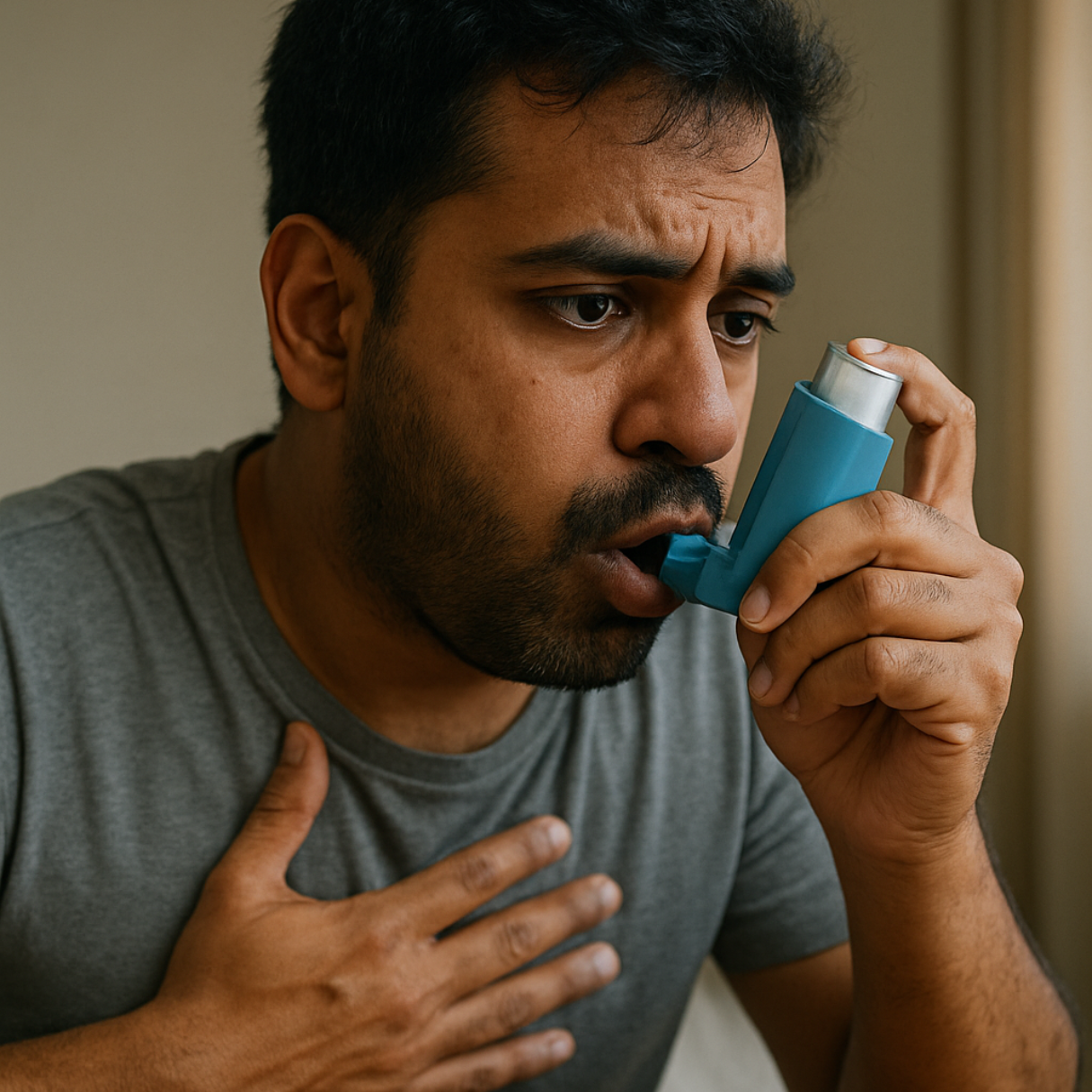
India’s Got No Chill -
Just Chronic Coughs
Relieve Respiratory
Symptoms with the
help of atovio Pebble
Relieve Respiratory Symptoms with
the help of atovio Pebble

1000+ People with Asthma, Bronchitis, and COPD now Breathe Cleaner, Safer Air
Dense Pollution Cleared
in 30 Seconds

India's Most Effective Portable Air Purifier
atovio Pebble- For Lungs that need extra care.
As Seen on
Breathe Better: Stories,
Science and Support
Pollen allergies, also known as seasonal allergic rhinitis or hay fever, affect millions of people worldwide, causing sneezing, itchy eyes, congestion, and breathing difficulties. In India, cities like Bangalore, Delhi, and Mumbai experience some of the highest pollen concentrations, making allergy symptoms a year-round struggle for many residents.
Pollen grains—microscopic particles released by trees, grasses, and weeds—become airborne and trigger immune system responses in sensitive individuals. The allergy season varies by region and plant type:
-
Tree pollen dominates in spring (March-May)
-
Grass pollen peaks in summer (June-August)
-
Weed pollen surges in autumn (September-November)
-
Winter (December-February) sees fewer pollen allergens but an increase in dust and indoor irritants
With rising pollution levels and climate change, pollen exposure is worsening in urban areas, making it crucial to understand triggers, seasonal patterns, and effective relief methods to manage symptoms and breathe easier.
Why Do Pollen Allergies Occur?
Pollen grains from trees, grasses, and weeds contain proteins that, when inhaled, cause the immune system to overreact. This leads to the release of histamines, triggering symptoms such as:
-
Runny or stuffy nose
-
Watery, itchy eyes
-
Sneezing and congestion
-
Sinus pressure and headaches
-
Fatigue and difficulty breathing
-
Asthma flare-ups in sensitive individuals
Common Pollen Allergy Triggers in India
India’s diverse plant ecosystem makes pollen allergies a year-round issue. Some of the most common pollen allergens include:
-
Tree Pollen: Peaks in spring & early summer from trees like Acacia, Casuarina, and Prosopis.
-
Grass Pollen: High during late summer from Bermuda grass, Parthenium, and Ryegrass.
-
Weed Pollen: Plants like Ragweed, Amaranthus, and Sagebrush release allergy-triggering pollen in the fall.
-
Crop Pollen: Regions with wheat, mustard, and rice farming have high pollen exposure.
-
Urban Pollution & Pollen Mix: In cities like Delhi and Mumbai, air pollution exacerbates pollen allergies, making symptoms more severe.
Ways to Manage Pollen Allergies
Minimizing pollen exposure and improving air quality can help control seasonal allergy symptoms. Here’s how:
-
Check daily pollen forecasts and limit outdoor activities during peak pollen times.
-
Shower & change clothes after outdoor exposure to remove pollen from skin & hair.
-
Keep windows closed during high pollen seasons to prevent allergens from entering indoor spaces.
-
Wear sunglasses & masks outdoors to reduce pollen contact with eyes and nasal passages.
-
Wash bedding and clothes frequently to remove pollen buildup indoors.
-
Drink warm fluids to soothe sinus inflammation and clear nasal passages.
Breathe Easier with Pollen-Free Air
Pollen allergies can make daily life uncomfortable, but proactive steps can help significantly reduce symptoms. Understanding triggers, seasonal changes, and protective measures can help allergy sufferers manage their condition effectively and breathe cleaner, healthier air year-round.
✅ Take control of your allergies and breathe easier every season with atovio!
Chronic Obstructive Pulmonary Disease (COPD) is a progressive lung condition that makes breathing difficult over time. It affects millions of people worldwide, with India being one of the most severely impacted countries. According to the Global Burden of Disease Study, India accounts for nearly 32% of global COPD deaths, making it a significant public health concern.
With increasing air pollution, smoking habits, and occupational exposure to harmful particles, COPD cases in India continue to rise. Early awareness, symptom management, and air quality improvements are key to reducing its impact.
What is COPD?
COPD is a group of chronic lung diseases, primarily including chronic bronchitis and emphysema, that cause airflow obstruction and breathing difficulties. Unlike asthma, which can be reversible, COPD worsens over time and has no permanent cure.
Key Facts About COPD in India:
- India has the second-highest number of COPD cases globally, with over 55 million people affected.
- According to the Lancet Report, COPD-related deaths in India have increased by 34% over the last two decades.
- Exposure to household air pollution (such as biomass smoke) is a major contributing factor, especially in rural areas.
Causes of COPD
COPD develops due to long-term exposure to irritants that damage the lungs. The most common causes include:
- Smoking & Tobacco Exposure – Around 70% of COPD cases in India are linked to active or passive smoking.
- Air Pollution – In cities like Delhi, Mumbai, and Kolkata, prolonged exposure to PM2.5 pollution increases COPD risk by 30%.
- Occupational Hazards – Workers in construction, mining, and textile industries inhale dust, chemicals, and fumes that damage lung tissue.
- Indoor Pollution – In rural India, over 60% of households use biomass fuels (wood, cow dung, coal) for cooking, leading to long-term lung irritation.
-
Genetic Factors – Some individuals may inherit Alpha-1 Antitrypsin Deficiency, a rare condition that increases COPD susceptibility.
Symptoms of COPD
COPD symptoms often appear gradually and worsen over time. Early diagnosis is crucial to managing the disease effectively.
Common Symptoms Include:
- Chronic Cough – Persistent coughing with mucus production.
- Shortness of Breath (Dyspnea) – Especially during physical activity.
- Wheezing & Chest Tightness – Increased difficulty in breathing.
- Frequent Respiratory Infections – Higher risk of pneumonia and bronchitis.
- Fatigue & Weakness – Reduced oxygen supply leading to tiredness.
-
Unintentional Weight Loss – In later stages, due to increased energy use during breathing.
Effects of COPD on Daily Life
COPD not only affects lung function but also has a significant impact on daily life and overall well-being.
- Reduced Physical Activity – Breathlessness makes simple activities like climbing stairs difficult.
- Mental Health Challenges – Studies show that 40% of COPD patients experience anxiety and depression.
- Increased Healthcare Costs – Frequent hospital visits, medications, and oxygen therapy can be financially burdensome.
- Higher Mortality Risk – COPD is the third leading cause of death worldwide, with a rising trend in India.
How to Manage COPD & Improve Air Quality
While COPD cannot be fully cured, lifestyle changes and air quality improvements can significantly slow its progression.
Effective Ways to Manage COPD:
Chronic Obstructive Pulmonary Disease (COPD) requires proactive lifestyle changes to improve lung function, reduce flare-ups, and enhance quality of life. Here’s how you can manage COPD effectively:
- Quit Smoking – The #1 cause of COPD progression; quitting can slow lung deterioration.
- Medication Management – Follow prescribed bronchodilators, steroids, and inhalers to keep airways open.
- Pulmonary Rehabilitation – Improves breathing techniques, endurance, and lung capacity through guided therapy.
- Oxygen Therapy – Helps maintain optimal oxygen levels, reducing breathlessness and fatigue.
- Stay Active – Low-impact exercises like walking and yoga can strengthen respiratory muscles.
- Healthy Nutrition – A balanced diet rich in antioxidants supports lung health and reduces inflammation.
- Avoid Environmental Triggers – Minimize exposure to pollution, allergens, and respiratory irritants.
- Manage Stress & Anxiety – Relaxation techniques like deep breathing and meditation improve lung efficiency.
- Regular Checkups – Frequent doctor visits help monitor symptoms and adjust treatment plans accordingly.
Prioritizing Lung Health
COPD is a growing health crisis in India, with millions affected due to air pollution, smoking, and occupational hazards. Raising awareness, early diagnosis, and improving air quality are crucial to managing symptoms and slowing disease progression.
By making conscious lifestyle choices and reducing exposure to harmful pollutants, individuals can take control of their respiratory health and improve their quality of life.
✅ Take steps today to protect your lungs and breathe better for a healthier future with atovio Pebble!
Smoking is one of the leading causes of preventable deaths worldwide, severely affecting both the heart and lungs. Whether you’re a smoker or exposed to secondhand smoke, the long-term damage from tobacco and nicotine can lead to chronic diseases, reduced lung capacity, and life-threatening conditions.
This blog explores how smoking harms cardiovascular and respiratory health and how air purification can help minimize secondhand smoke exposure for a healthier lifestyle.
The Devastating Effects of Smoking on the Lungs
The lungs are one of the first organs to be affected by cigarette smoke. With each inhale, harmful chemicals, tar, and fine particulate matter (PM2.5) enter the respiratory system, leading to:
-
Destruction of Alveoli – Smoking damages the tiny air sacs in the lungs, reducing oxygen absorption.
-
Chronic Bronchitis & COPD – Tar buildup increases mucus production, leading to a chronic smoker’s cough and breathing difficulties.
-
Lung Cancer Risk – Long-term exposure to carcinogens in cigarette smoke significantly raises the likelihood of lung cancer.
-
Reduced Lung Function – Over time, smokers experience shortness of breath, wheezing, and irreversible lung scarring.
How Smoking Affects the Heart
Smoking not only damages the lungs but also puts immense strain on the cardiovascular system. Here’s how:
-
Narrows & Hardens Arteries – Reduces blood flow, increasing the risk of heart attacks and strokes.
-
Elevates Blood Pressure & Heart Rate – Forces the heart to work harder, leading to long-term damage.
-
Increases Blood Clots – Nicotine and carbon monoxide reduce oxygen levels, making blood thicker and more prone to clotting.
-
Leads to Atherosclerosis – The buildup of plaque in arteries causes coronary heart disease (CHD).
The Hidden Dangers of Secondhand Smoke
Even if you don’t smoke, exposure to secondhand smoke can be just as dangerous. Studies show that breathing in tobacco smoke can:
-
Increase the risk of lung infections & asthma attacks.
-
Cause cardiovascular diseases in non-smokers.
-
Harm children & pets, leading to developmental and respiratory issues.
How atovio Can Help Reduce Secondhand Smoke Exposure
While quitting smoking is the best way to protect your health, atovio’s Advanced Variable Anion Technology () helps reduce exposure to airborne toxins by:
-
Neutralizing harmful chemicals & fine particulate matter from cigarette smoke.
-
Reducing airborne carcinogens, preventing them from circulating indoors.
-
Providing portable air purification for enclosed spaces like homes, offices, and cars.
-
Scientifically validated at IIT Kanpur, ensuring up to 90% reduction in airborne pollutants.
Additional Tips to Minimize Smoking-Related Health Risks
-
Avoid smoking indoors to reduce indoor pollution.
-
Use an air purifier like atovio Pebble to eliminate lingering toxins.
-
Stay hydrated to flush out harmful chemicals from the body.
-
Engage in regular exercise to strengthen lung capacity and heart health.
-
Seek smoking cessation programs for long-term health benefits.
– Protect Your Heart and Lungs
Smoking is a silent killer, but awareness and proactive steps can help reduce its impact on your health. Whether you’re a smoker or concerned about secondhand smoke, taking steps to improve air quality can make a significant difference.
atovio Pebble offers a powerful air purification solution to neutralize cigarette smoke pollutants, helping create a cleaner and healthier environment for you and your loved ones.
✅ Take control of your air quality today! Get atovio Pebble Now
With air pollution levels reaching hazardous levels in major Indian cities, asthma and allergy sufferers are facing severe health risks like chronic respiratory diseases, lung inflammation, and reduced lung function. According to the Indian Study on Epidemiology of Asthma, Respiratory Symptoms, and Chronic Bronchitis in Adults (INSEARCH), India’s national asthma burden has reached 17.23 million cases, with a prevalence rate of 2.05%. Over the last decade, asthma cases have surged due to worsening air quality, with the Global Burden of Disease Report revealing a nearly 67% increase in asthma prevalence since 1990. Additionally, hospital admissions for respiratory distress have risen by 25% in the last five years. Studies show that exposure to PM2.5 increases the risk of asthma attacks by 40%, and nearly 50% of urban children suffer from chronic respiratory issues triggered by airborne toxins. Cities like Delhi, Mumbai, and Bangalore, where air quality index (AQI) levels regularly exceed safe limits, have reported a significant rise in respiratory diseases. With pollutants such as PM2.5, pollen, dust mites, and pet dander worsening symptoms, protecting respiratory health has become more critical than ever
atovio’s Advanced Variable Anion Technology provides a proactive air purification solution, helping individuals breathe cleaner, fresher air whether at home, in the office, or while commuting.
Understanding Airborne Triggers for Asthma & Allergies
Certain cities in India, like Bangalore, Delhi, Mumbai, and Pune, experience higher pollen levels, worsening allergies for residents. Bangalore, in particular, is known for its high pollen count, triggering seasonal allergies in many individuals. Poor air quality combined with pollen can make breathing difficult for asthma sufferers.
Several airborne irritants can worsen asthma and allergies, including:
- PM2.5 & PM10: Fine particulate matter that penetrates deep into the lungs, worsening respiratory symptoms.
- Pollen & Allergens: Seasonal allergens that trigger sneezing, congestion, and breathing difficulties.
- Dust Mites & Pet Dander: Invisible yet potent allergens commonly found in homes and public spaces.
-
Mold Spores & VOCs: Present in damp environments, causing respiratory distress and allergic reactions.
How atovio’s Anions Technology Works Against These Pollutants
Unlike traditional air purifiers, atovio uses Advanced Variable Anion Technology (), which releases millions of anions per second to neutralize airborne irritants. Here’s how it works:
- anions attach to airborne pollutants, making them too heavy to stay in the air.
- Reduces PM2.5 and allergens by up to 90% (Tested at IIT Kanpur).
- Unlike HEPA filters that just trap particles, atovio neutralizes pollutants at a molecular level, ensuring fresher air.
Benefits of Using atovio for Asthma & Allergy Relief
- Instant relief from airborne allergens – Helps reduce sneezing, coughing, and congestion.
- Reduces indoor and outdoor air pollution exposure – Whether at home, in the office, or while commuting.
- No filters = No accumulation of dust and bacteria – Unlike traditional air purifiers, which require constant filter replacements.
- Portable protection – Atovio Pebble provides on-the-go purification in metros, offices, and homes.
- Scientifically validated at IIT Kanpur, proving its efficiency in improving air quality for respiratory health.
Real-Life Use Cases – Who Can Benefit the Most?
- Children & Elderly Individuals – More vulnerable to air pollution & allergens.
- Office Workers & Commuters – Exposure to poor indoor air in offices and public transport.
- Pet Owners – Reduces pet dander and related allergies.
- Frequent Travelers – atovio Pebble ensures cleaner air in flights, trains, and hotels.
Why atovio is Better Than Traditional HEPA Filters for Allergy Relief
- No need for frequent filter replacements – HEPA filters collect dust and require costly upkeep.
- Neutralizes pollutants instead of just trapping them – Prevents allergen re-exposure.
- Works in open spaces & enclosed areas – Provides an active breathing zone of purified air.
Breathe Easier with atovio
Backed by science & tested at IIT Kanpur, atovio helps asthma and allergy sufferers live healthier lives by actively purifying the air around them. Whether at home, work, or on the move, atovio offers continuous protection against airborne irritants, ensuring a cleaner and safer breathing environment.
✅ Breathe better, live better – Buy atovio Pebble Now!
Transform Your Family’s Asthma Health with Our Personal Air Purifier
Nature's Air Purifiers: The Power of Anions
atovio: Bringing Nature's Freshness to You
A Level Above in Every Way

Features of atovio Pebble
No Filter Replacement
Easy maintenance. Hassle free use.
Personal Air Zone
Your bubble of clean air anytime anywhere
Variable Anion Technology
Millions of anions neutralizing airborne pollutants
Compact & Wearable
Lightweight and easy to carry
Long Battery Life
40+ hours of continuous use
Quiet Operation
Your silent partner of clean air
Two Modes of Operation
Switch to turbo mode for higher performance
USB-C Charging
Quick and convenient charging
Easy Maintenance
Simple care for lasting performance



































